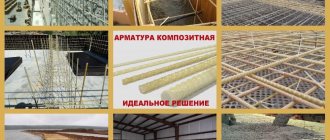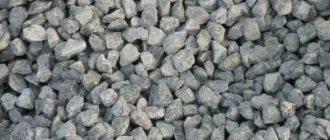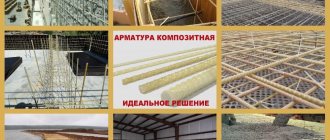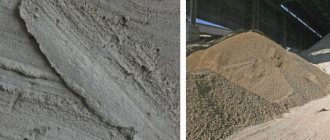Beton-House.com
Website about concrete: construction, characteristics, design. We combine the experience of professionals and private craftsmen in one place
Laying mixtures
Expanding concrete (GOST 32803-2014) is a material containing prestressing cement or special expanding additives to form prestressing structures during the curing period of the mixtures.
As a result of such setting conditions for the solution, it is possible to obtain expanding concrete that has increased density, water resistance and durability (see video in this article).
- Properties
- Modifying expansion additives
Coefficient of linear expansion of concrete
Linear expansion coefficients of building materials
The table shows the values of the coefficient of linear expansion of building materials (CTLE) and some metals at temperatures up to 100°C.
The dimension of the expansion coefficient in the table is m/(m °C) or 1/deg (K-1). The table considers: aluminum Al, copper Cu, steel, granite, basalt, quartzite, sandstone, limestone, wall brick, clinker brick, sand-lime brick, lightweight concrete stones, aerated concrete blocks, concrete, reinforced concrete, cement mortar, lime mortar, complex plasters, wood, parallel to the grain, glass.
Of these building materials, clinker brick has the lowest coefficient of thermal linear expansion (its CTE is 3.5·10-6 1/deg), as well as wood, plasters, wall bricks and basalt. It should be noted that a high coefficient of thermal expansion is characteristic of metals such as aluminum, copper or steel. For example, the coefficient of linear expansion of aluminum is 24·10-6 1/deg, which is 2 times more than that of steel.
The coefficient of thermal linear expansion shows how much (relative to the size of the body) the material will elongate when its temperature increases by 1 degree.
To calculate the increase in the linear dimensions of a material due to thermal expansion, it is necessary to multiply the value of the temperature coefficient of linear expansion by the linear dimension of the material and by the temperature difference in degrees Celsius or Kelvin. For example, a wall brick (CTLR = 0.000006 deg-1) with a length of 240 mm will elongate by 0.144 mm when heated by 100 degrees.
From the values of the coefficients of thermal expansion in the table, it can be seen that the indicated building materials and metals have a positive coefficient of linear expansion, that is, they increase their size (expand) when heated.
Source: V. Blasi. Designer's Handbook. Construction physics. M.: Tekhnosphere, 2004.
Density of concrete. Shrinkage and swelling of concrete. Heat capacity, thermal conductivity and linear coefficient of thermal expansion of concrete.
Density of concrete. Shrinkage and swelling of concrete. Heat capacity, thermal conductivity and linear coefficient of thermal expansion of concrete.
The practical density of heavy (ordinary) concrete is 2.3 g/cm3 = 2300 kg/m3. (1.8-2.7 g/cm3).
Shrinkage and swelling of concrete.
Changes in the size of concrete structures due to changes in concrete moisture content are called shrinkage and swelling. Occurs even at constant temperature.
The shrinkage of concrete is of a rather complex nature, but the fact is that when concrete hardens in air, upon drying it will have a shrinkage of the order of 0.3 mm per meter of linear size. The greater the proportion of cement in the solution, the higher the shrinkage. With a large thickness of concrete, it will dry on the outside, but not yet on the inside, which leads to the appearance of internal stresses and defects.
The reverse process - the swelling of dry concrete under the influence of moisture is characterized by the same value of 0.3 mm/m. The greater the proportion of cement in the solution, the higher the swelling.
Therefore, even for the operation of a concrete structure under constant temperature conditions, it is necessary to provide shrinkage joints.
Heat capacity, thermal conductivity and linear coefficient of thermal expansion of concrete.
The change in the linear size of concrete under the influence of temperature is characterized by a linear coefficient of thermal (temperature) expansion. The characteristic value of the coefficient for concrete is 0.00001 (°C)-1, therefore, with a temperature change of 80 °C (-40/+40 °C), the expansion reaches approximately 0.8 mm/m. Therefore, expansion joints are required in any concrete structure.
The temperature shrinkage joint in the Russian Federation certainly cannot be less than 1.1 mm per meter of linear size (0.3 mm - shrinkage, 0.8 - temperature), in SNIPs the values are higher and they, of course, are mandatory when required. Keep in mind that temperature fluctuations greater than 80°C will almost certainly cause cracking of rigid aggregate concrete due to the difference in thermal expansion of the mortar and aggregate.
The thermal conductivity of monolithic concrete in an air-dry state is 1.35 W/(m*°C) = 1.5 kcal/(h*m*°C). The high thermal conductivity of heavy concrete requires mandatory insulation of external concrete walls.
The thermal conductivity of porous concrete is from 0.35 to 0.7 W/(m*°C) = 0.3-0.6 kcal/(h*m*°C), but with a huge decrease in strength.
The specific heat capacity of heavy and porous concrete in a dry state is about 1 kJ/(kg*°C) = 0.2 kcal/(kg °C)
The volumetric heat capacity of heavy concrete is about 2.5 kJ/(m3*K) and that of porous concrete depends on density.
The specific heat capacity of the concrete mixture (not hardened) is about 1.5 kJ/(kg * °C) = 0.3 kcal/(kg °C), but remember - the mixture is lighter than heavy concrete and heavier than porous concrete.
Heat capacity of concrete Expansion coefficient of concrete
When building houses using concrete, calculations are always made, so for this you definitely need to know the specific heat capacity of concrete. The specific heat capacity, or simply the heat capacity of concrete, is very important and cannot be avoided in construction, when, for example, the thermal conductivity of a structure is calculated in order to determine the costs of accelerating the hardening of a concrete structure.
The heat capacity of concrete is the amount of heat that needs to be transferred to concrete in order for its temperature to change by one unit.
Related articles: Benefits of foam concrete
Concrete expansion coefficient
The changing size of concrete, due to the influence of temperature, is indicated by the coefficient of expansion of concrete. The size of this coefficient of expansion of concrete is 0.00001 (ºC)-1, which means that if the temperature changes by 80 ºC, the expansion will be about 0.8 mm/m. It turns out that any concrete building requires expansion joints.
Temperature shrinkage seams
Temperature shrinkage joints in Russia should be starting from 1.1 mm per 1 m, concluding from the calculation that 0.3 mm is shrinkage + 0.8 is the temperature coefficient. In building codes and regulations (SNIP), the dimensions are larger; it is also worth considering that temperature changes of the order of 80 ºС or more cause cracks in concrete, which has a hard filler inside, because there is a difference in the expansion coefficients of the solution and the internal filler.
- Houses made of foam concrete blocks
- How much cement is in a cube of concrete
Heat capacity of concrete
The thermal conductivity of monolithic concrete, provided that it is air-dry, is about 1.35 W/(m*ºC) = 1.5 kcal/(h*m*ºC). The high thermal conductivity characteristics of such heavy concrete make it necessary to use insulation of external walls made of monolithic concrete.
The thermal conductivity of porous concrete and its varieties is about 0.35 - 0.75 Wt/(m*ºC)= 0.3-0.6 kcal/(h*m*ºC), keep in mind that the strength of such concrete is much lower.
Preparation of expanding mixtures
Making your own mixtures
Expanding and tensile concrete, if necessary, can be prepared with your own hands, at the construction site.
There are two main methods for producing quick-hardening waterproof mixtures:
- using tensile and expanding cements;
- using special expanding additives based on Portland cement.
The consumption of modified cements and the proportions in relation to aggregates are the same as for the preparation of conventional heavy concrete. Instructions for preparing expanding mixtures using Portland cement are individual for each additive. The proportions and procedure are described on the back of the product packaging.
Thermal expansion coefficient of concrete
Concrete expansion coefficient
Determining the coefficient of expansion of concrete belongs to the category of rheological research - that is, a direction devoted to the deformation and fluidity of substances.
The coefficient of thermal or thermal expansion is a value that shows the change in volume and linear parameters of a product with a change in temperature and constant pressure. This property applies to all substances and materials that have an atomic-molecular structure. When they are heated, the distance between individual atoms and molecules increases (for liquids and gases) or the range of vibrations of elements in the crystal lattice of solids increases, which results in an increase in their volume. This indicator is inextricably linked with such a characteristic as thermal conductivity. The latter is defined as the ability of a product to transfer heat passing through its thickness. Thermal conductivity is directly related to the composition of the material. The denser its structure, the higher this indicator.
Thermal conductivity indicators of heavy and light concrete differ significantly. The thermal conductivity of heavy concrete is much higher than that of cellular concrete, which is their significant disadvantage. Therefore, walls made of heavy concrete require additional insulation. Moreover, the latter also depends on the level of environmental humidity.
The expansion coefficient of concrete is 0.00001°C. This means that when the ambient temperature increases by 50°C, the concrete structure is capable of increasing in volume, and this indicator will be within 0.5 mm/m. The range of temperature fluctuations exceeding 80°C leads to an increase in this indicator. The value of the linear stress coefficient is also influenced by the size of the filler fraction: the higher it is, the greater this indicator. An increase in the volume of the constituent parts of a concrete structure leads to the emergence of strong internal stresses in the material, as a result of which the slabs begin to crack and crumble, which immediately affects the duration of their operation, reducing it significantly.
To prevent the negative consequences of this phenomenon, expansion joints are used, which are depressions made on the surface of the material. It is they, and not the slab itself, that take the main load when deforming forces occur.
- Concrete quality control
Concrete quality control is an integral part of its production cycle. Control is implemented in the following forms: as carrying out preliminary checks of the quality of raw materials used in the production of concrete products; as control over technology.
Class and grade of concrete
The quality of concrete, like any other building materials, is regulated by state standards. The classification they established allows you to control the quality of products and easily navigate through their range, choosing the required class in.
Artificial concrete stone
In recent decades, concrete has been used not only as a construction material, but also as a decorative material. Artificial stone made from concrete, obtained by applying its additional processing, allows you to create an imitation practically.
Shrinkage and thermal expansion of refractory concrete
Shrinkage for refractory concrete is an important indicator, since such concrete (unlike conventional refractory products) is not pre-fired, but is heated directly in the structural elements. Consequently, all shrinkage of refractory concrete occurs in working condition, i.e. already during the operation of the thermal unit. When heated, stresses arise in concrete, depending on factors such as thermal expansion or shrinkage of the constituent components, temperature and heating rate, elastic-plastic properties and limiting deformations of the constituent components, the relative amount of substance in the concrete that shrinks when heated, grain composition and maximum size of aggregate grains.
Due to internal stresses when heating refractory concrete, not only elastic, but also plastic and residual deformations can occur, and in this case the structure is disrupted, which affects the properties of refractory concrete, including shrinkage.
In the temperature range from 600 (700) to 800°, the shrinkage curve has an approximately horizontal section, i.e., shrinkage does not increase with increasing temperature. Obviously, in this interval the structure of concrete changes. Indeed, the strength of concrete in this range decreases most sharply. At temperatures above 800°, further “loosening” of the concrete structure occurs and its strength decreases to a minimum at approximately 1000°.
The apparent shrinkage of concrete decreases noticeably, or even vice versa—the concrete seems to increase in volume. Obviously, the behavior of cement stone also corresponds to this, i.e., the sometimes observed decrease in shrinkage at a temperature of 1000° compared to shrinkage at 800°. At temperatures of 800–1100°, the linear shrinkage of refractory concrete based on Portland cement ranges from 0.2 to 0.7%.
Metal-plastic pipes
Metal-plastic pipes are a complex structure consisting of five layers - a pipe made of “cross-linked” (modified) polyethylene, an adhesive layer, a thin aluminum pipe, an adhesive layer and a protective shell of polyethylene. The aluminum layer has virtually no effect on the operational parameters of the pipes - operating pressure and temperature. The liquid inside the pipe moves not through an aluminum pipe, but through a plastic pipe, and therefore it is the properties of cross-linked polyethylene that determine the operational parameters of the pipe. The main task of the aluminum layer is to create a diffusion barrier that prevents the penetration of oxygen from the atmosphere into the pipe. Another purpose of the aluminum layer is to partially compensate for the thermal expansion of the polymer pipe. Since the coefficient of linear thermal expansion of polymers is 10–12 times higher than that of steel, when used in hot water supply and heating systems, internal stress arises in metal-plastic pipes, which the adhesive layer transfers to the aluminum layer, which compensates for this stress. Since different layers of the pipe expand differently, delamination of the pipes may occur during operation. Metal-plastic pipes are even more vulnerable to freezing. When water expands inside the pipe due to freezing, the aluminum pipe becomes deformed and there is a risk of rupture of the weld in the inner polypropylene pipe.
However, when choosing this pipeline material, ease of operation and installation of pipes are decisive compared to all other types of pipes. The problem of linear extension of plastic pipes is easily solved with the help of special compensators. The linear elongation compensation functions performed by the aluminum layer make sense only when laying open pipes in heating systems, where the length of the pipelines is quite large. In cold water supply systems and heated floors (where the pipes are embedded in concrete), compensation is not needed at all.
CHAPTER 7. Durability of concrete
Thermal expansion coefficient of concrete
The value of the coefficient of thermal expansion of concrete depends on the composition of the concrete mixture and humidity during the period of temperature change. Cement stone and aggregate have different coefficients of thermal expansion, and the coefficient of thermal expansion of concrete reflects the ratio of materials in the composition of concrete.
The coefficient of thermal expansion of cement stone ranges from 10ХУ
6 at 1°C. It is larger than that of the aggregate. The coefficient of thermal expansion of concrete depends on the amount of aggregate in the mixture (Table 7.10) and the expansion coefficient of the aggregate.
The effect of humidity is determined by the components of the cement stone and is determined by the fact that the coefficient of thermal expansion is composed of two parts: the actual kinetic thermal coefficient and the swelling pressure.
The latter increases with a decrease in the capillary pressure of water in the cement stone with increasing temperature. Swelling is not possible if the sample is dry, i.e. does not contain water, and if it is saturated. Consequently, at these two limiting states the coefficient of thermal expansion is less than at partial saturation.
In Fig. 7.25 and 7.26 show data for cement stone. In concrete we observe the same dependencies, although the coefficient of thermal expansion changes less, since only cement stone reacts to changes in humidity and age. In table Table 7.11 shows the values of the coefficients of thermal expansion of concrete with a composition of 1:6, hardened in air at 64% relative humidity, in water and moistened after air hardening.
Only the values determined on saturated and dried samples give the actual values of the coefficient of thermal expansion, but values at intermediate values of humidity are necessary since they reflect the actual operating conditions of the concrete - if the increase in temperature during the transition from winter to summer is accompanied by drying, shrinkage and net expansion occur less than in the absence of water loss from concrete.
The chemical composition and fineness of cement grinding affect the value of the coefficient of thermal expansion only insofar as they affect the properties at an early age. The presence of air pores has no effect.
All of the above applies to normal temperatures below 40° C.
Higher temperatures can occur, for example, in airfield pavements when exposed to exhaust gases from jet engines and in industrial environments. In Fig. 7.27 shows that at temperatures above 320°C the coefficient of thermal expansion of concrete increases, possibly due to dehydration of the cement stone. The values of the coefficient of thermal expansion are given in table. 7.12.
Laboratory tests have shown that concretes with a high coefficient of thermal expansion are less resistant to temperature changes than concretes with a lower coefficient of expansion. In Fig. Figure 7.28 shows the results of tests of concrete subjected to repeated heating and cooling in the temperature range 4.4-60 ° C at a rate of 2.4 ° per minute. However, the coefficient of thermal expansion cannot serve as a quantitative characteristic of the durability of concrete exposed to frequent or rapid temperature changes.
But a faster temperature change than under normal conditions can cause concrete to deteriorate. In Fig. Figure 7.29 shows the effect of rapid cooling after heating to the specified temperature.
SNiP 2.06.08-87. Concrete and reinforced concrete structures of hydraulic structures Part 4
7. CALCULATION OF CONCRETE AND REINFORCED CONCRETE ELEMENTS
DESIGNS FOR TEMPERATURE
AND HUMIDITY INFLUENCES
7.1. Temperature effects should be taken into account:
a) when calculating concrete structures for strength in accordance with clause 5.1, as well as when calculating them for the formation (prevention) of cracks in cases where a violation of the solidity of these structures can change the static scheme of their operation, cause additional external force influences or an increase in back pressure, lead to a decrease in water resistance and durability of the structure;
b) when calculating statically indeterminate reinforced concrete structures, as well as when calculating reinforced concrete structures for the formation (prevention) of cracks in the cases specified in clause 6.1;
c) when determining deformations and movements of structural elements for the purpose of designing expansion joints and anti-filtration seals;
d) when assigning temperature conditions required by the conditions of construction of the structure and its normal operation;
e) when calculating thin-walled reinforced concrete elements of non-rectangular cross-section (T-shaped, ring-shaped) in contact with the ground.
Temperature effects may not be taken into account in the calculations of thin-walled structures if freedom of movement of these structures is ensured.
7.2. When calculating concrete and reinforced concrete structures, the temperature effects of the operational and construction periods should be taken into account.
Temperature impacts during the operational period include climatic fluctuations in the temperature of outside air, water in reservoirs, and operational heating (or cooling) of the structure.
The temperature effects of the construction period are determined taking into account exotherm and other conditions of concrete hardening, including constructive and technological measures to regulate the temperature regime of the structure, the temperature of the closure of construction joints, the complete cooling of the structure to the average long-term operating temperature, fluctuations in the temperature of the outside air and water in reservoirs.
A specific list of temperature effects taken into account in the calculations of concrete and reinforced concrete structures of the main types of hydraulic structures must be established by the design standards for the corresponding types of structures.
7.3. In calculations of concrete and reinforced concrete structures of hydraulic structures for temperature effects, with appropriate justification, it is allowed to take into account the thermal effect of solar radiation.
7.4. Taking into account moisture influences when calculating concrete and reinforced concrete structures should be justified depending on the possibility of shrinkage or swelling of the concrete of these structures.
It is allowed not to take into account concrete shrinkage in calculations:
thin-walled structures located under water, in contact with water or covered with soil, if measures were taken to prevent concrete from drying out during construction.
7.5. Temperature and humidity fields of structures are calculated by methods of building physics using the basic principles adopted for non-stationary processes.
7.6. Data on outdoor air temperature and humidity and other climatological characteristics should be taken on the basis of meteorological observations in the construction area. In the absence of such observations, the necessary information should be taken according to SNiP 2.01.01-82 and according to official documents of the State Hydrometeorological Service.
The water temperature in reservoirs should be determined on the basis of special calculations and analogues.
7.7. For Class I structures, the thermophysical characteristics of concrete are established on the basis of special studies. For structures of other classes and during the preliminary design of structures of class I, the specified characteristics of concrete can be taken according to table. 1 and 2 recommended application 2.
7.8. The deformation characteristics of concrete necessary for calculating the thermally stressed state of structures are allowed to be accepted:
initial modulus of elasticity of concrete, MPa, at an age of less than 180 days - according to the formula
where is the dimensionless parameter taken according to the table. 3 recommended applications 2;
— age of concrete, days;
the initial modulus of elasticity of concrete aged 180 days or more should be taken in accordance with clause 2.15.
The creep characteristics of concrete should be taken according to table. 4 recommended apps 2.
For Class I structures, the deformation characteristics of concrete should be clarified by research on samples of concrete of production composition.
7.9. Calculation of concrete and reinforced concrete structures for the formation (prevention) of temperature cracks should be made according to the formulas:
a) when checking the formation of cracks and determining their sizes
For the formation of a surface crack, it is necessary that condition (74) be satisfied within the tensile zone, the depth of which in the direction perpendicular to the surface would be at least 1.3, where is the maximum size of the coarse concrete aggregate;
b) when preventing cracks in structures calculated according to the second group of limit states,
c) when preventing cracks in structures calculated according to the first group of limit states,
where and are, respectively, the standard and design resistance of concrete to axial tension, determined in accordance with clause 2.11;
— coefficient of transition from the standard axial tensile strength of concrete to the average axial tensile strength of concrete of the production composition, determined in accordance with clause 7.10;
— coefficient taking into account the dependence of concrete axial tensile strength on age and adopted in accordance with clause 7.11;
— modulus of elasticity of concrete, determined in accordance with clause 7.8;
- coefficient of working conditions, equal to 1.1 for massive structures, 1.0 for others;
— work of tensile stresses at the corresponding difference between total and forced temperature deformations in concrete:
where is the current time;
— concrete temperature at the moment of time;
— temperature coefficient of linear expansion of concrete;
— concrete deformations determined taking into account the time-varying modulus of elasticity and creep of concrete;
— tensile stresses in concrete:
where are the stresses in concrete, determined taking into account the time-varying modulus of elasticity and creep of concrete.
7.10. The coefficient is determined by the formula
where is a coefficient depending on the established level of guaranteed strength of concrete and equal to 1.64 at = 0.95 and 1.28 at = 0.90;
— coefficient of variation in the strength of concrete of the production composition.
In projects of concrete and reinforced concrete structures of hydraulic structures, = 0.135 at = 0.95, = 0.17 at = 0.90 should be taken.
7.11. The value depending on the age of the concrete should be taken for the construction period according to table. 5 of the recommended Appendix 2, for an operating period usually equal to 1.0.
For buildings of classes I and II, the coefficient should be clarified by research on large-scale samples of concrete of production composition.
Linear expansion coefficient of basalt plastic
S.P.Osnos, V.N.Sadkov, M.N.Kiselev
The thermal expansion of bodies is characterized by a linear or volumetric expansion coefficient. The true coefficient of linear expansion (true CTE) is the ratio of the increase in the linear size of a basalt-plastic rod of unit length to the small change in temperature that caused the change in size. In practice, the average linear expansion coefficient is used:
Where L is the length of the rod at the initial temperature T; Lt is the length of the rod heated to temperature T.
The table shows the values of the coefficients of thermal expansion of some materials in the temperature range from 15°C to 200°C.
Thermal expansion coefficients
Window sheet glass
Lead glass (crystal)
Solid aluminium-borosilicate glass
Aluminum borosilicate glass fiber
KTE is one of the most important performance properties of basalt plastic. The correct selection of CTE for a number of important areas of application of these materials determines not only the quality of the resulting products, but also the very possibility of their manufacture. For example, when using basalt plastic as reinforcement for concrete products, to prevent internal cracking of concrete during large temperature fluctuations, components with similar CTE values are selected. The CTE of basalt plastic is determined by the quartz dilatometer method, the essence of which is to measure the absolute elongation of the sample when it is heated. The CTE measurements of the samples were carried out on a vertical quartz dilatometer of the DKV type. A sample of plastic 50 mm long and 5 mm in diameter, measured with an accuracy of 0.1 mm, was placed in a quartz test tube in an oven and secured between a ground cylindrical quartz glass plate resting on a spherical support soldered into the bottom of the test tube and the end of a quartz rod. , transmitting the extension to the meter - indicator. The rate of temperature rise in the oven is 3-4°C per minute; the temperature in the furnace was measured by a chromel-alumel thermocouple, the emf of which was determined by a potentiometer. The linear expansion coefficient (a) was determined by the formula:
What determines pipe elongation: calculation methodology
The degree of thermal elongation of the pipeline depends on several main factors: the maximum temperature of the coolant, environmental conditions at the time of installation and during operation of the pipeline. In this case, the length of the straight segment and CTE are taken into account. The specified values are reflected in a formula that allows you to determine the increase in size for a specific system. In the case of cast iron, the following calculations must be used:
ΔL=L*α*ΔT ΔL = change in length in mm, where:
L = pipe length in m;
α = linear elongation coefficient;
ΔT = temperature difference Tmax-Tmin.
For example: Pipe length = 50 meters Tmax = +40°C Tmin = +4°C. Installation temperature = +25°C Δt (heat) = (+40) – (+4) = +36°C ΔL = 50*0.015*36 =27 mm. This is exactly how much the pipe will be extended over a section of 50 m.
How is the coefficient of linear expansion of concrete calculated?
In order to build a durable building, experts determine the linear expansion coefficient of concrete. This way the builder can find out how much the material will change in length after heating. Such calculations make it possible to avoid premature deformation of the building, the appearance of cracks and increase the operational durability of the structure.
- What it is?
- How to calculate the thermal expansion index?
- Temperature indicator
- Heat capacity
- How to regulate?
What it is?
The term coefficient of expansion of concrete refers to how much a building material expands as temperature increases.
The concept is related to the heat capacity and thermal conductivity of the solution. Concrete that can expand contains admixtures or prestressing cement. Thus, the result is a stable mixture that can change in size. In addition, to create the structure, seams are needed to support the blocks. If there is too much temperature difference, the concrete may crack. To do this, they try to correctly select the composition of the material with a high coefficient, so the occurrence of cracks can be prevented.
How to calculate the thermal expansion index?
You can measure the expansion yourself. To do this, the original length is measured. Afterwards the temperature rises by 1 degree. It is worth remembering that the heat level should be the same throughout the entire perimeter. Afterwards, the amount of elongation is specified. A microscope is used to make micro changes. In addition, the coefficient of thermal expansion of concrete can be calculated using the formula: l=l0(1+α⋅ΔT). In this equation, l represents the expansion, ΔT is the temperature at which the change occurred, and l0 is the initial length.
Temperature indicator
The coefficient can be found in the table, which gives average values. According to tabular data for concrete, this indicator is 0.00001 (ºС)-1. So, at 80 degrees the increase will be 0.8 mm/m. But such tabular data are not quite accurate, since all schemes provide average values. Therefore, it is advisable to measure or calculate indicators yourself.
This indicator will be different for each type of material.
Heat capacity
The coefficient of thermal expansion is inextricably linked with the heat capacity used in construction. This term refers to a certain amount of heat that the mixture needs in order to raise the temperature. Since there are several types of solutions, the coefficient will vary depending on the fillers. Thus, the heat capacity of air-dry concrete is 1.35 W (m*°C). This indicates that the indicator is high and therefore additional insulation is needed. Porous mixtures have a low heat capacity (0.35-0.75 W).
This coefficient also depends on the heat capacity of the material.
How to regulate?
The value depends on the following factors:
- temperature;
- Class;
- filler.
Aggregate and cement have different temperature coefficients. Therefore, when heated and expanded, deformation may occur and cracks may appear. To prevent this from happening, special stitches are used. In addition, the reinforcement of the building structure is increased. Concrete is divided into separate blocks. But these methods are expensive and not always effective. Therefore, for the result, tensing and expanding binders are used.
Water vapor pressure
The thermal expansion of gases depends on their elasticity, that is, their ability to return to their original volume. Ziegler was the first to explore this issue in the mid-eighteenth century. But the results of his experiments varied too much. More reliable figures were obtained by James Watt, who used his father’s boiler for high temperatures and a barometer for low temperatures.
At the end of the 18th century, the French physicist Prony attempted to derive a single formula that would describe the elasticity of gases, but it turned out to be too cumbersome and difficult to use. Dalton decided to empirically test all the calculations using a siphon barometer. Despite the fact that the temperature was not the same in all experiments, the results were very accurate. So he published them in table form in his physics textbook.
Molecular homogeneous connection (fusion) provides a double margin of safety at the joints. Special L-shaped Aquatherm tubes simplify installation; they have fastenings to the radiator with a platform; the platform has a specialized mounting hole for fixing to the subfloor. As a result, there is no movement of the tubes, it is convenient to connect devices, and there is no need to install radiators in advance.
Aquatherm pipes must be laid in a channel of sand or fine soil and compacted in such a way as not to damage them. A minimum distance of 75mm between the pipe and the bottom surface of the floor is recommended. All pipes must be laid at right angles to the concrete floor. Any piping that crosses the slab structure must be laid at right angles to the surface of the slab and must be insulated with flexible plastic material at the intersection, at least 6 mm thick for the entire length of the intersection with the slab (Aquatherm Technical Bulletin 1012B-AQTTB1)
Coefficient of linear expansion of concrete
- About company
- Product Catalog
- Construction design
- Industrial engineering
- Construction and installation
- Production
- Foam glass FOAMGLAS
- Thermal insulation Aspen Aerogels
- Removable thermal covers
- About the material General information
- Physical properties
- Products made from FOAMGLAS
- Permits
- Brochures
- Foundations
- Pipelines
- Adhesives
- Adhesives










